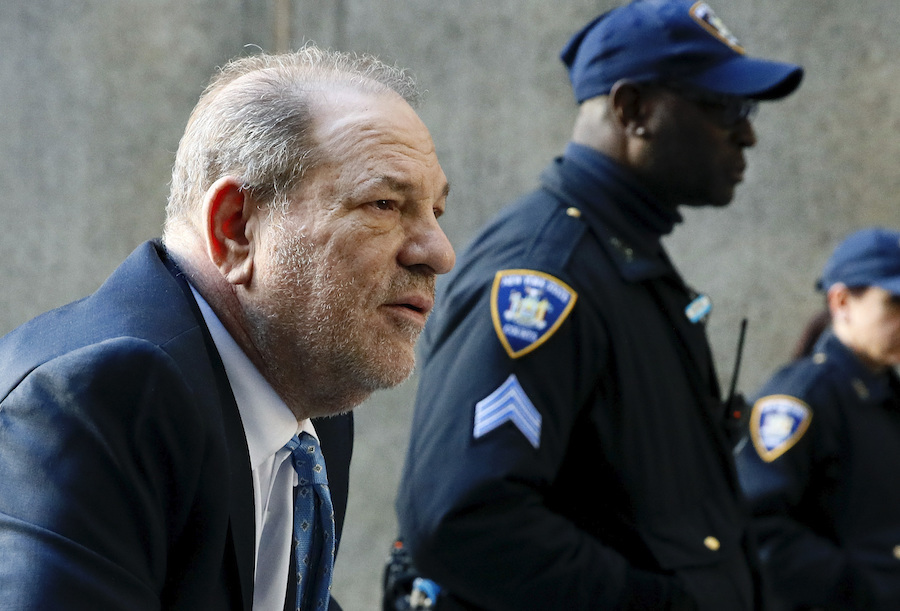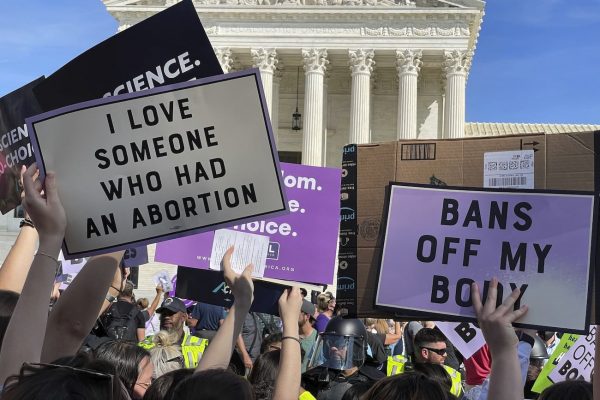What We Don’t Talk About When We Talk About #MeToo
JoAnn Wypijewski
Verso, $26.95 (cloth)
In February the New York Times published an editorial, “The Lessons of #MeToo’s Monster,” emblazoned with a large illustration of Harvey Weinstein’s silhouette. In place of Weinstein’s mouth is a couch; its legs resemble fangs. The editorial discusses the difficulties of bringing Weinstein to justice and the limitations of the law on matters of sexual violence, but the graphic is noteworthy, too. Considered in isolation, it evokes the public trial of Oscar Wilde in 1895 on charges of “gross indecency”—that is, engaging in homosexual acts. Newspaper coverage made him into a monster, a looming predator preying upon unsuspecting young men.
Wypijewski argues that “moral panic” has been a constant aspect of American public life for at least the past thirty years.
Of course there is a difference. Wilde was a gay man, persecuted for engaging in a consensual relationship with an adult man on the basis of immoral laws since overturned; Weinstein is a rapist and serial sexual harasser who does not deserve our sympathy. But the specter and the spectacle are similar, even across the span of more than a century: Wilde and Weinstein, men of monstrous paunch slavering over the innocent, predators who must be banished both materially and symbolically, so that all the bad behavior they stand for can be banished too.
JoAnn Wypijewski’s new collection What We Don’t Talk About When We Talk About #MeToo takes this impulse to create public monsters as emblematic of a moral weakness in our ideas about sexual harm. Wypijewski’s overarching subject is what she calls the “substitution effect,” which “typifies cases involving public demons.” As Wypijewiski sees it, the ritualistic doling out punishment to particular offenders—the ones who don’t get away—often comes to substitute for “all the actions never taken against all the accused.” Weinstein is just one example; these sixteen essays offer a range of other case studies. Together they argue that “moral panic” has been a constant aspect of American public life for at least the past thirty years.
That general thesis may not be as controversial as her choice to gather certain examples, including Weinstein, under its banner. Wypijewski defines such a panic as “a social eruption fanned by the media and characterized by alarm over innocence (stereotypically, white women and children) imperiled.” The bracketed emphasis on white women is revealing: Wypijewski asks us to consider whose victimhood matters in public life, and which ends it serves. Excessive attention to the misdeeds of individuals, she argues, distracts us from the systems that enable injustice and from what we must do to change them. But there is a dangerous amount of conflation in the book that distracts from the value of this critique. One questions the value of including an essay about former South Carolina governor Mark Sanford’s extramarital affair in a litany of variegated violences. Sex scandals involving hypocritical public figures—including the latest imbroglio with Jerry Falwell, Jr.—are a thing apart from accusations of abuse, though they get the same sensationalized treatment in many quarters. To place a reflection on Sanford between essays on the institutional enabling of child abuse is a careless false equivalence.
Excessive attention to the misdeeds of individuals, Wypijewski argues, distracts us from the systems that enable injustice and from what we must do to change them.
Some of Wypijewski’s keenest observations concern the “pinched . . . privileged” conception of sexual threat’s impact in the workplace. “#MeToo discourse borrows the anti-harassment piece,” she writes, “but separates it from work’s full reality, which is to say capitalism.” Sexual harm, she stresses, is just another tool in the boss’s arsenal for humiliation, discipline, and profit maximization. This more wide-ranging conception of abuse in the workplace recalls Tessa McWatt’s notion of the “plantation mentality” in Shame on Me (2019), which eloquently argues for the plantation as capitalism’s model for the merging of sexual violence, labor, and exploitation. Wypijewski nods to this concept in reference to the Black radical feminist Combahee River Collective, asking:
What conversations might we be having now if Combahee’s analysis of power—rooted in the black woman’s interrelated experiences of production, reproduction and violence—had become standard feminist analysis all those years ago?
By contrast, white women’s feminism—with its tactical over-emphasis on “personal story as public fodder”—leaves us ill equipped to fully examine the unjust structure of the workplace. The personal story and the sensationalized villain conspire to obfuscate our pressing need for a more holistic conception of human dignity. If “sex in the workplace” were the sole measure of dignity, Wypijewski writes, “strawberry pickers who haven’t been sexually harassed should be happy agents of their destiny.” The problem is that nothing will quite “raise the temperature of politics to the same fever as sexual accusation,” as Wypijewski demonstrates again and again, from the handling of the AIDS epidemic to homophobic hate crime.
• • •
Though these essays represent a collection of Wypijewski’s longform reporting over the past twenty-odd years, at times elegant links appear. In the chapter “Make the Rules, Break the Rules and Prosper,” Wypijewski reflects on Christine Blasey Ford’s testimony against Brett Kavanaugh: how it overshadowed—and prevented sufficient public examination of—Kavanaugh’s role as a paper-pusher of the CIA torture program in the early 2000s. The essay builds off an earlier chapter on the Abu Ghraib trials in 2005. What decisively captured widespread public attention in that case was not the fact of torturing, but the pictures taken of a handful of soldiers laughingly inflicting a variety of sexualized harms and humiliations on prisoners. Lynndie England became the target of particularly lurid interest: young and female, she was therefore most shocking when she posed grinning next to hooded prisoners as they were forced to masturbate, make a naked human pyramid, and be pulled by a leash on all fours.
MeToo can be understood as the fruiting body of work—and harm—done a long time ago.
The aim of the resulting “soap opera,” as Wypijewski calls it, was to prove “the Pentagon’s theory that the humiliations at Abu Ghraib could be understood as the work of a few deviants.” One narrative deployed by both the defense and the prosecution featured guard Charles Graner as the main villain, seducer of England, who directed her to pose with prisoners as part of a wider sexual game. The prosecution “intended to draw a straight line of moral decay from the girl who would blow her boyfriend on camera to a girl who would laugh at prisoners forced to simulate fellatio.” England was the lowest ranking of the soldiers accused, and faced the longest prison sentence (thirty-eight years, eventually sentenced to three and discharged after less than two). “Except for a handful of low-level working-class soldiers,” Wypijewski reminds us, “everyone who ordered, justified, implemented or looked the other way at the torture policy got away with it. Elite men and women got a step up.” Kavanaugh is another case in point. In both cases, Wypijewski contends, the core issue is U.S. war crimes, but reckoning is precluded by the mass distraction of sexual scandal.
Wypijewski pursues similar themes in essays such as “A Boy’s Life” and “The Secret Sharer.” The former concerns the horrific 1998 murder of University of Wyoming student Matthew Shepard in Laramie and his subsequent “resurrection as patron saint of hate crime legislation.” But the brutality of the murder acts as a fig leaf for deeper self-examination about attitudes to homosexuality, both in Laramie and the nation at large. In the words of a local source, “They’re demonizing those boys [Shepard’s murderers] so they don’t have to look at themselves.” The responding pledge was “tolerance,” but, in the era of Don’t Ask, Don’t Tell, that “ was something one had for a bad job or a bad smell.” In “The Secret Sharer,” a young African American man conveniently embodies sexual stranger danger in a prudish small town. In 1997 NuShawn Williams, then twenty, admitted to having unprotected sex with several women after learning he was HIV positive and was identified as having started a micro-epidemic of HIV in Chautauqua County, NY. Public health officials broke confidentiality, and posters bearing his picture were plastered all over town. Having served a twelve-year prison sentence, he is currently held in a psychiatric prison.
Beyond establishing similar patterns of the symbolic villain or victim, however, these essays flail about. Both begin as hard-edged social reportage—gritty, nihilistic New Journalism missives from rural and deprived America—only to give way to squishier notions of personal desire. “Sex brought the promise of something good, something intimate, something sweet and fleshy and maybe pleasurable,” Wypijewski writes, dropping out of an analytical register into a more lyrical or personal one: “To be held in someone’s arms, to be kissed, to be entered and, in the act, forgiven for not being the most beautiful or the most responsible or the most stable; to be forgiven for the restless dream of wanting.” “Secret Sharer” chapter jackknifes from drugs, to HIV, to medical ethics, to carceral justice, to abuse, love, and sex education. Williams proves a tricky subject for empathy because of his tendency to be violent with partners and to sleep with underage women. As such, he serves to illustrate one of Wypijewski’s opening questions: “Does our pity depend on something so wispy as innocence?”
Wypijewski can also be dangerously self-defeating and inconsistent in her deployment of data. On the Boston priest scandal of 2002, she writes, citing the grim statistics from the annual federal Child Maltreatment report (which records abuse perpetrated by relatives or caregivers): “The suffering child is terrible, whatever the cause, but there’s no payoff in shattering the illusion of home, no journalism prizes.” This is an odd assessment: Wypijewski creates a false equivalence between the home and the church as agents of child suffering. It is not that child abuse that occurs within the home should not be brought to light, but in this particular forum, Wypijewski’s slanted focus feels an almost willful misapprehension of the issue: high-level institutional wrongdoing. Elsewhere she deploys this outrageous passage of anecdotal whataboutery:
The priest scandal has raised a hysteria against which any rational line on youthful sexuality has about as much chance as that student facing the tank in Tiananmen Square. Even without that, nothing seems to make the blood boil like the suggestion that it’s possible for teenagers to emerge unscathed or even enriched from consensual sexual relations with adults. Some leftist friends recoil, even as I ask, what about X, who says it was like an answered prayer when his parents’ thirtyish friend initiated him sexually at thirteen, when for months afterward at the end of the school day he would politely kiss his same-age girlfriend (now his wife of decades) and then rush to this experienced woman’s bed? What about Y, who seduced her married teacher when she was seventeen and he forty-five, and who, thirty years later, has with this same man one of the most egalitarian unions I have ever seen?
Passages such as these leave the reader feeling they are being addressed at the pitch of controlled shout, and Wypijewski’s more astute observations run the risk of being lost in the noise.
The perpetrators of abuse have their specific attributes, but revelations of their behavior occur in light of one another, and the virulent eruption of MeToo is the result of a cumulative reckoning.
The non-chronological arrangement of the essays themselves also does a disservice to Wypijewski’s argument, and only two of the sixteen essays deal with events after the New York Times broke the Weinstein allegations in October 2017. There is value in looking at some of #MeToo’s antecedents, but the temporal back and forth undermines the purported project of the book, ultimately scrambling the evolution of the movement it claims to be examining. The effect is of logical whiplash, hurled from Mark Sanford’s affair, to teenage sexuality, to Madonna’s album Sex. Quotes from interviewees and sources float freely through several essays, italicized, their speaker unnamed or unexplained.
As a result of this organization, a fundamental aspect of #MeToo goes unexamined in this book: the movement’s origins, which seemed to some to spring out of nowhere and to others to come out of decades of work. Rebecca Solnit offers the term “mushrooming” in relation to the historiography of uprisings and revolutions more broadly in Hope in the Dark (2004):
After a rain mushrooms appear on the surface of the earth as if from nowhere. Many do so from a sometimes vast underground fungus that remains invisible and largely unknown. What we call mushrooms mycologists call the fruiting body of the larger, less visible fungus. Uprisings and revolutions are often considered to be spontaneous, but less visible long-term organizing and groundwork—or underground work—often laid the foundation.
In other words, MeToo can be understood as the fruiting body of work—and harm—done a long time ago. A friend of mine who had been integral to the 2018 revelations and reparations surrounding historical abuse at the Hotchkiss School in Connecticut cited the 2015 Oscar-winning film Spotlight as a key catalyst in encouraging alumni to come forward. (The movie was based on the Boston Globe’s investigation into clerical abuse in the Boston archdiocese dating as far back as the 1970s.) Their first story was published in 2002 and followed by some 300 more. Sexual harm is historical. The public reaction to Weinstein builds off of Donald Trump, Bill Cosby, Jimmy Savile, and decades of sexual abuse uncovered by the Globe and other outlets. The perpetrators of abuse have their specific attributes, but revelations of their behavior occur in light of one another, and the virulent eruption of MeToo is the result of a cumulative reckoning, in some ways dating back to Tarana Burke’s work in 2006 and in others extending further beyond it. The prosecution of these individuals is undoubtedly a “symbolic sacrifice for all the priests”—and by extension, other predatory men—“who got away.”
• • •
Wypijewski never delves systematically into the interrelationship between carceral politics and sexual violence. While she deplores the brutality of incarceration, she suggests no alternatives.
Wypijewski’s overarching interest in punishment is only glimpsed in snatches. “Satisfaction in the humiliation of enemy-others is so everyday,” she writes, “that as a culture we seem incapable of recognizing it as an extension of the violence we deplore.” This critique comes with an indictment of formal mechanisms of punishment: “As citizens of the biggest prison state, the leading exporter of violence, we should consider how even arguments against violence may be colonized by it.” Yet Wypijewski never delves systematically into the interrelationship between carceral politics and sexual violence. While she deplores the brutality of incarceration, she suggests no alternatives. The same problem besets Mithu M. Sanyal’s 2019 cultural history Rape: From Lucretia to #MeToo, which notes how “unimaginably common” rape is in the U.S. prison system and condemns the system itself as a symptom of inequality and sham democracy. The more equal a society, she ventures, “the higher its opportunities for participation, the lower its rape rate.” But this assertion comes at the very end of her book, and the same, sadly, applies to Wypijewski’s. Chroniclers of the problematic functions that sexual violence and its spectacle serve in our societies, both Sanyal and Wypijewski offer no way of moving past them.








